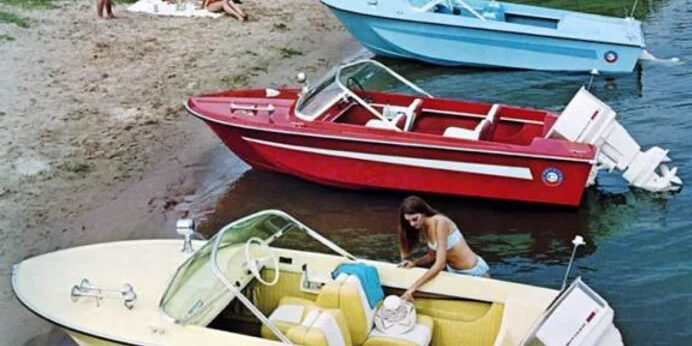In the late 60s, 70s, and early 80s, boat dealerships proliferated, as did manufacturers. Prior to this time, few dealerships—as we know them today—existed. Boatyards might build their own wooden boats or maybe represent one builder. The advent of fiberglass changed everything—with exponential growth in terms of manufacturers, dealers, and of course, customers.
It was much easier to learn to build a fiberglass boat as opposed to a wooden one and of course, it took far less time. Within a few short years, most harbors and lakes had at least one boat dealership, sometimes more than one. Obtaining a dealership was not difficult because there were so many brands to choose from and manufacturers were in a hurry to get their products into the marketplace. Territories at that time were generally close to the location of the dealership. It was common to have dealers selling the same brand only 100 miles or so apart, maybe less.
It was also routine for a dealership to represent multiple brands and types of boats. You might have a high-end brand, a mid-level brand, a high-performance brand, and maybe an entry-level brand. Of course, this would depend on the type of customers and boating appropriate for your location.
The requirements for representing a brand of boats in the early years were minimal. You basically expressed an interest in ordering and selling boats and the manufacturer was glad to have you. It was also easier for the dealer because boats were much simpler, less complicated, less expensive, and quicker to commission and deliver. Because territories were small, there was little, if any, travel required to service the boats we sold.
Business was brisk and taking trades was usually not onerous because there were plenty of buyers. Few special skills were required to put together and service most boats and you could train staff relatively quickly. Dealers are responsible for the warranty service of boats they sell and in those days, warranty issues were normally simple and easy to remedy.
How does the above picture compare to the dealership of today? Things are much different now. First of all, there are far fewer manufacturers of pleasure boats, and far fewer dealers representing them. The boats themselves are more sophisticated, complicated, and expensive. The financial requirements of a dealership and their service capabilities are of utmost importance to the manufacturers.The dealer must have the ability to stock the boats expected of them by the manufacturers, as well as take trades. In simple terms what a manufacturer requires of a dealership today is substantially more than it was decades ago.
Manufacturers understand that a dealership can enhance or detract from the reputation of the brand. This is why manufacturers want their dealers to abide by the territory limitations in their dealer agreements. It is understood that when dealers sell boats out of territory, the customer typically does not receive the desired level of service. At the same time, because there are fewer dealers today, each of us has a larger territory than we used to have. The manufacturer prefers to have fewer, but larger and stronger dealers, whom they feel will do a better job for their customers. The increased size of the territory puts an extra burden on the dealership for service and warranty.
The dealership staff of today must be better trained than ever before. This applies across the board—to sales, service, and office employees. Picture the motor in your vehicle of 40 years ago compared to what is under the hood today. Service staff needs to go to school now. Everything is more complicated and expectations are higher than ever. More emphasis is placed on the dealership for marketing and enhancing the local image of the brand. You can imagine expenses are greater than ever before accordingly, which is another reason why dealers need a sizable territory: to generate the income required.
Manufacturers of today generally prohibit dealers from selling products that are competitive with theirs. We can have multiple lines of boats, as long as we maintain an adequate level of financial commitment to each brand, and the brands complement, as opposed to compete, with one another. In a sense, this is self-limiting because it costs a lot to represent each brand and only the largest dealers in major markets can manage more than two or three brands. This is just an overview and there is much more to the story, as you could imagine, but this should give you a basic idea of why today’s dealerships are the way they are.








